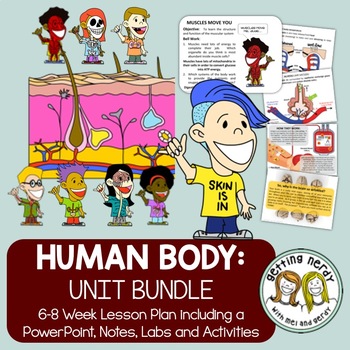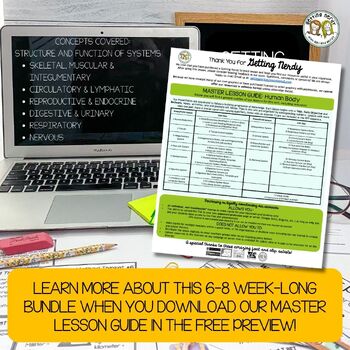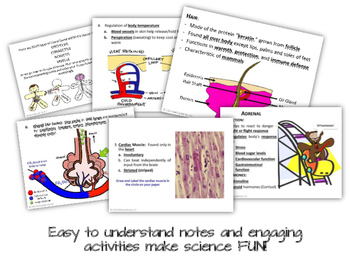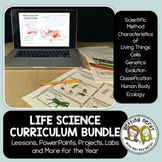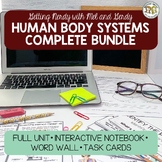Human Body Systems - PowerPoint & Handouts Bundle
- Zip
- Google Apps™

What educators are saying
Also included in
- Everything you need at your fingertips! Teach an entire YEAR of life science with over 35 weeks of lessons in this curriculum bundle - including daily warm-ups, lessons, labs, activities, projects, study guides and assessments, and an animated PowerPoint for each of the following units: Scientific MPrice $399.95Original Price $537.15Save $137.20
- Unit Lesson Plans complete with guiding PowerPoint and student pages? ✓Word walls? ✓ Interactive Notebooks? ✓Task Cards? ✓You're ready to teach with this comprehensive bundle for teaching the Human Body. Engage your students with our animated PowerPoints and aligned lessons, 30 Interactive NotebookPrice $99.95Original Price $120.35Save $20.40
Description
The leg bone's connected to hip bone... learn all about the major systems of the body from the integumentary system to the nervous system using our fun and engaging human body unit bundle, complete with a guiding PowerPoint, tons of activities, graphic organizers and more!
WHAT'S INCLUDED in this 6-7 WEEK LONG BUNDLE:
• 170+ slide fully editable PowerPoint presentation with title slides, objectives, bell work, guided notes, and animations along with 100+ NON-EDITABLE PDF pages which includes aligned notes, labs, projects, activities, study guide and assessments covering the following topics:
→ Integumentary system
→ Muscular system
→ Skeletal system
→ Respiratory system
→ Circulatory and lymphatic systems
→ Digestive system
→ Excretory and Urinary systems
→ Male and Female Reproductive systems
→ Endocrine system
→ Nervous system
• DIGITAL GOOGLE CLASSROOM links to all items listed above which can be easily converted to Microsoft School with directions provided or altered to fit your school’s personal learning management system
TO ACCESS THE MATERIALS NEEDED FOR THIS UNIT, CLICK HERE.
STUDENTS WILL:
• Follow along with the PowerPoint as they complete the aligned lessons, activities, projects and labs
THIS PRODUCT IS ALSO FOUND IN OUR:
• Human Body Systems Complete Bundle - PowerPoint Unit, INB, Task Card, Word Wall
• Life Science Biology Curriculum Bundle
CHECK OUT OUR OTHER HUMAN BODY PRODUCTS :
• Human Body Systems - Interactive Notebook Activity Pack
• Human Body Systems Bundle - STEAM Science Centers / Lab Stations
• Human Body Systems - Word Wall
• Human Body Systems - Task Cards
• Integumentary system - Human Body "I Have . . . Who Has?" Game/Activity
SEE HOW THIS LESSON ALIGNS WITH THE NGSS, TEKS or GSE
Because we have created many of our own graphics or have purchased licenses to other graphics with permission, we cannot offer our resources in editable format unless otherwise stated.
TERMS OF USE (TOU):
All rights reserved by GETTING NERDY®️
• This product is to be used by the original purchaser only
• Intended for classroom and personal use only
• Copying for more than one teacher, classroom, department, school, or school system is prohibited
• This product may not be distributed or displayed digitally for public view
Failure to comply is a copyright infringement and a violation of the Digital Millennium Copyright Act (DMCA). Clipart and elements found in this PDF are copyrighted and cannot be extracted and used outside of this file without permission or license.
Human Body Systems - PowerPoint and Handouts © 2012 to present Getting Nerdy ®️ All Rights Reserved
www.gettingnerdyscience.com

